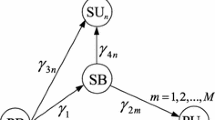Abstract
In cognitive radio network, the spectrum sharing is considered where secondary (unlicensed) users’ communication co-exists with primary (licensed) users’ communication in the presence of an interferer, and the interferer has a significant impact on the primary performance. Hybrid ARQ (automatic-repeat-request) retransmission mechanisms are employed at primary and interfering links. Based on the mechanisms, a cooperate-and-access spectrum sharing protocol is proposed where the secondary system switches between cooperation mode with forwarding interference and access mode with decoding interfering packet. In the cooperation mode, the secondary transmitter forwards information about the interference to the primary receiver for interference mitigation. Thus, the primary performance is improved compared to the traditional non-cooperative communication system and credits are collected by the secondary system. Adequate credits allow the secondary system running on the access mode, i.e. the secondary packet is delivered to the secondary receiver by using the primary spectrum. Then, compared to the traditional system the primary performance is degraded in the access mode. The condition that this degradation can be fully offset by the advantage accrued from interference mitigation is investigated. The primary throughput in cooperation and access modes and the secondary throughput in access mode are derived. Numerical results show that the proposed protocol has the equal or higher average primary throughput than the traditional system in the low primary SNR region. In addition, when the average transmits SNR of the primary is less than that of the interfering user, the proposed protocol is more efficient than the protocol in Li et al. (IEEE Transactions on Communication 60(10):2861–2870, 2012).






Similar content being viewed by others
References
Mitola, J., & Maguire, G. Q. (1999). Cognitive radio: Making software radios more personal. IEEE Personal Communications, 6(4), 13–18.
Haykin, S. (2005). Cognitive radio: Brain-empowered wireless communications. IEEE Journal on Selected Areas in Communications, 23(2), 201–220.
Goldsmith, A., Jafar, S., Maric, I., & Srinivasa, S. (2009). Breaking spectrum gridlock with cognitive radios: An information theoretic perspective. Proceeding of the IEEE, 97(5), 894–914.
Manna, R., Louie, R. H. Y., Li, Y., & Vucetic, B. (2011). Cooperative spectrum sharing in cognitive radio networks with multiple antennas. IEEE Transactions on Wireless Communication, 59(11), 5509–5522.
Han, Y., Pandharipande, A., & Ting, S. H. (2008). Cooperative spectrum sharing via controlled amplify-and-forward relaying. In Proceeding of IEEE personal, indoor and mobile radio communications (PIMRC) (pp. 1–5).
Han, Y., Pandharipande, A., & Ting, S. H. (2009). Cooperative decode-and-forward relaying for secondary spectrum access. IEEE Transactions on Wireless Communication, 8(10), 4945–4950.
Han, Y., Ting, S. H., & Pandharipande, A. (2010). Cooperative spectrum sharing protocol with secondary user selection. IEEE Transactions on Wireless Communication, 9(9), 2914–2923.
Han, Y., Ting, S. H., & Pandharipande, A. (2012). Cooperative spectrum sharing protocol with selective relaying system. IEEE Transactions on Communication, 60(1), 62–67.
Zou, Y., Zhu, J., Zheng, B., & Yao, Y. (2010). An adaptive cooperation diversity scheme with best-relay selection in cognitive radio networks. IEEE Transactions on Signal Processing, 58(10), 5438–5445.
Dabora, R., Maric, I., & Goldsmith, A. (2008). Relay strategies for interference-forwarding. In Proceeding of IEEE information theory workshop (pp. 46–50).
Maric, I., Dabora R., & Goldsmith, A. (2008). Interference forwarding in multiuser networks. In Proceeding of IEEE global telecommunications conference (pp. 1–5).
Li, Q., Ting, S. H., & Pandharipande, A. (2012). Cooperate-and-access spectrum sharing with ARQ-based primary systems. IEEE Transactions on Communication, 60(10), 2861–2870.
Elkourdi, T., & Simeone, O. (2013). Spectrum leasing via cooperative interference forwarding. IEEE Transactions on Vehicular Technology, 62(3), 1367–1372.
Heinzelman, W. B., Chandrakasan, A. P., & Balakrishnan, H. (2002). An application-specific protocol architecture for wireless microsensor networks. IEEE Transactions on Wireless Communication, 1(4), 660–670.
Acknowledgments
This paper is funded by the National Science Foundation of China (NSFC-AF 60911130512), the National Science and Technology Major Projects (Nos. 2012ZX03003012-004 and 2013ZX03003016), the Creative Research Groups of China (61121001), the Program for Changjiang Scholars and Innovative Research Team in University (PCSIRT No. IRT1049) and the project under Grant No. 201105.
Author information
Authors and Affiliations
Corresponding author
Rights and permissions
About this article
Cite this article
Xie, P., Li, L., Zhu, J. et al. A Cooperation and Access Spectrum Sharing Protocol with Cooperative Interference Management. Wireless Pers Commun 81, 997–1015 (2015). https://doi.org/10.1007/s11277-014-2167-3
Published:
Issue Date:
DOI: https://doi.org/10.1007/s11277-014-2167-3




